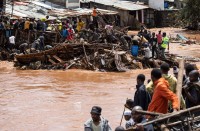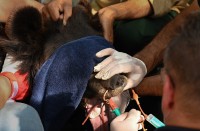The collapse of two dams at a Brazilian mine has cut off drinking water for quarter of a million people and saturated waterways downstream with dense orange sediment that could wreck the ecosystem for years to come.
Nine people have been left dead, 19 are still listed as missing and 500 people were displaced from their homes when the dams burst at an iron ore mine in southeastern Brazil on November 5.
The sheer volume of water disgorged by the dams and laden with mineral waste across nearly 500 km (311 miles) is staggering: 60 million cubic metres (2,119 cubic feet), the equivalent of 25,000 Olympic swimming pools or the volume carried by about 187 oil tankers.
President Dilma Rousseff compared the damage to the 2010 oil spill by BP PLC in the Gulf of Mexico and Environment Minister Izabella Teixeira called it an “environmental catastrophe.”
The disaster is the latest assault on the Rio Doce, or “Sweet River”, one of the main routes connecting mineral-rich Minas Gerais state with the Atlantic Ocean.
Once lined with thick rainforest and populated by indigenous tribes, the waterway has long suffered because of ravenous demand for the minerals nearby.
Environmentalist and biologist, Mario Moscatelli, said Brazilian authorities needed to step up environmental regulations to prevent similar accidents in the future.
“When a problem like this happens, no one wants to take responsibility. But in addition to the (mining) companies, we also need to consider the responsibility of the environmental agencies, because the risks that these dams faced of collapsing had already been identified. But there are other dams that may also be at risk and are only being assessed now because of this catastrophe,” he said.
Scientists say the sediment, which may contain chemicals used by the mine to reduce iron ore impurities, could alter the course of streams as they harden, reduce oxygen levels in the water and diminish the fertility of riverbanks and farmland where floodwater passed.
Lake Candonga, which formed behind a hydroelectric dam on the Rio Doce, has mostly vanished under a thick layer of mud and shredded trees.
The lake was often used by residents of Santa Cruz do Escalvado for fishing and riding jet skis. But now most fish lay dead in the mud.
Ronaldo Pereira, who owns a bar located on the margins of the Candonga, said the environmental losses would have a terrible impact on his business.
“I’m hoping that they will clean this as fast as possible and work to recover the local environment, which has suffered a lot in this region. The fish are dying, the trees are dying… Not to mention our human losses, with all the families who lost their loved ones,” he said.
Samarco Mineração SA, a joint venture between mining giants Vale SA and BHP Billiton and owners of the mine, has repeatedly said the mud is not toxic.
But biologists and environmental experts disagree. Local authorities have ordered families rescued from the flood to wash thoroughly and dispose of clothes that came in contact with the mud.
Environmentalists warn that as the heavy mud hardens, it will make farming difficult. And so much silt will settle along the bottom of the Rio Doce and the tributaries that carried the mud there that the very course of watershed could change.
Environmental police have been documenting the damages and sending reports to federal prosecutors in charge of the case.
Lieutenant Porto, one of the members of the environmental brigade, said it was still difficult to determine the extent of the damage, but the mining companies would have to pay for the recovery efforts.
“Nature is very wise, so it responds quickly. But we have to wait and see, because the damage was enormous and it is difficult to measure it at this point. The environmental police, besides monitoring everything, we are putting all this into police reports which are being sent to state prosecutors in Mariana responsible for this case and who will adopt measures to charge the (mining) companies and push them to help improve the conditions in the environment, which I believe should recover, although it may never be like it once was,” he said.
Now the Rio Doce is running a reddish brown. Farmhands are being forced to move livestock away from its banks, afraid to let cattle drink the water.
Researchers are testing the river water and results should be published over the coming weeks, giving a better idea of the contents of the mining waste.
One cause for concern is that compounds known as ether amines could have been used at the mine to separate silica from the iron ore, in order to produce a better quality product. At least some of the compounds, according to the website of Air Products, a company that produces them, are not readily biodegradable and are highly toxic to aquatic organisms. They can also raise PH levels to a point that is environmentally harmful.
Moscatelli said the mining companies should be held accountable.
“What happened was an unprecedented catastrophe. Life in the river is now extinct. Now what we need to do is prevent that similar accidents from take placing in Brazil and calculate the cost of the entire recovery process that these companies will have to pay for,” he said.
The river’s banks are now barren and bed full of silt, making it more prone to flooding with heavy rains that over the years devastated communities along its more than 800 km- (497 mile-) course.
One of the families who felt the effects of the tragedy was that of 42-year-old mule driver, Vadilson Moreira. Living in a poor home with his wife and two children, he has been filling water buckets since supplies were cut after the dams burst.
Outside his window, ducks swim in the muddy stream that remained after the sludge passed.
He said he and his neighbours would no longer be able to enjoy a swim in the river.
“We used to have a lot of fun here. The people here would go take a swim on a small beach on the other side of the river. But today we can no longer do that,” he said.
As the mud flows toward the ocean, environmentalists fear its impact on the coast too.
The mouth of the Rio Doce is a nesting area for endangered sea turtles, an animal sensitive to chemical changes in the water. The beaches are expected to turn a deep red. (Reuters)







